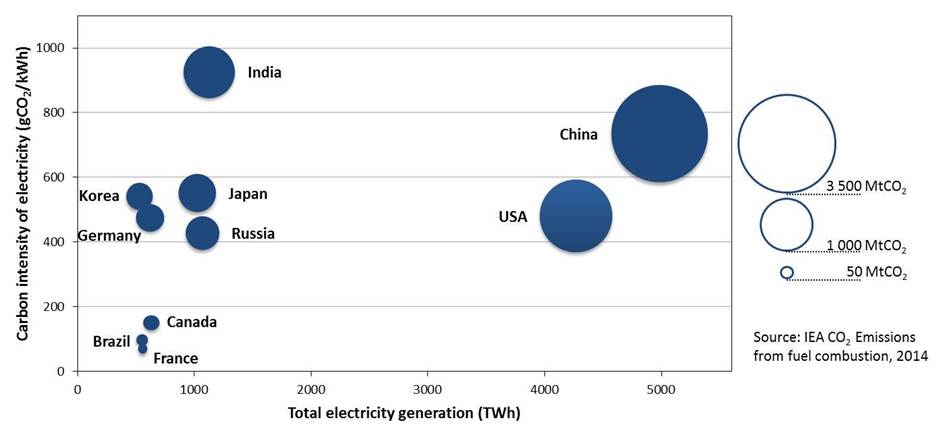|
Can India Combat Climate Change
How much electricity does India need? T he International Energy Agency’s (IEA) suggested threshold electricity consumption is 250 kWh and 500 kWh per household per year for rural and urban households respectively1. In rural areas, 250 kWh can power a floor fan, a mobile phone and two light bulbs. In urban areas, consumption might include a small refrigerator, a second mobile phone and a small television.However, according to World Bank data, no country in the world with an income per capita above $10,000 has electricity consumption below 3,880 kWh/person/year – nearly eight times the IEA target for a whole urban household2! According to IEA statistics, India’s per capita consumption of electricity in 2012 was 760 kWh (US stood at 12,950 kWh, China at 3480 kWh and Brazil 2150 kWh). While this is above IEA thresholds (on average), it is far below what it should be for Indians to enjoy the lifestyle the West takes for granted. But what would it mean for climate change if India provides 3880 kWh/person/year – a fivefold increase over the present? Electricity and emissions Emissions associated with electricity generation may be estimated as the product of 2 variables: • carbon intensity of electricity generation measured in kg CO2 per kWh of electricity generated • total electricity generated measured in kWh (units) India’s carbon intensity of electricity generation (0.7 to 0.9 kg CO2/kWh) is one of the highest in the world, as the production mix is dominated by coal. In comparison, in Norway, Iceland and Paraguay, emissions are less than 0.02 kg CO2/kWh3. Due to the high carbon intensity, India’s total emissions are also high despite low levels of electricity generation, as demonstrated in the graph. Let us explore emissions implications of bridging the gap between current per capita consumption of 760 kWh and desired 3880 kWh. Doing so in the Business As Usual scenario (increasing production capacity without changing the proportions of each fuel in the production mix) will entail additional carbon emissions of over 2 metric tonnes per capita. This would almost double current emissions of 2.44 metric tonnes per capita4. If the proportion of low-carbon sources (solar, wind, nuclear, etc.) in the production mix were increased, such that low-carbon sources account for 50% of the production mix and coal’s proportion is reduced from the current 60% to 40%, the carbon intensity of electricity generation decreases, and therefore so does the quantity of emissions. In this scenario, additional emissions would amount to approximately 1.5 metric tonnes per capita: a 30% improvement over scenario 1, but still a 60% increase over current carbon emissions per capita (Source: Author). The numbers may be alarming, but they should be seen in perspective. In the high-carbon scenario, India’s per capita carbon emissions would rise to 4.5 to 5 metric tonnes per capita. This is quite small compared to US’s 19.86 metric tonnes, China’s 8.13 metric tonnes and EU’s 8.77 metric tonnes at present5. Due to large population, overall emissions in India are likely to be higher. In fact, India’s total emissions may become highest in the world. However, from a social justice perspective, the per capita numbers are equally important. The IEA’s threshold energy consumption is abysmally low compared to the developed-world consumption levels. Fortunately, there are significant gains possible in carbon intensity of electricity production, which may alleviate the problem to an extent. q Harshini Shanker Endnotes 1 International Energy Agency, 2011, Energy for all: financing Access for the poor, Paris: OECD/IEA 2 Kenny, C., 2015, If Everyone Gets Electricity, Can the Planet Survive? The Atlantic, 28 September 2015 3 Shrink That Footprint, (n.d.), Electricity emissions around the world. Available at: http://shrinkthatfootprint.com/electricity-emissions-around-the-world 4 The Times of India, 3 Oct 2015, Emission intensity cut leaves scope for growth 5 Ibid |
